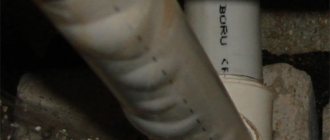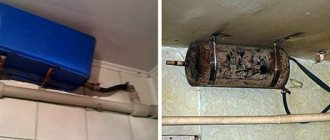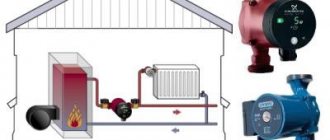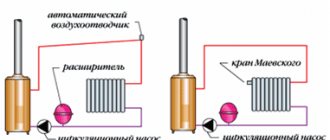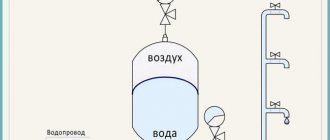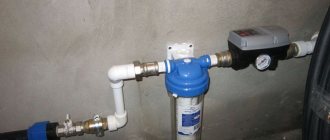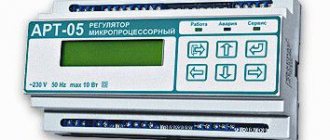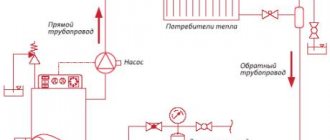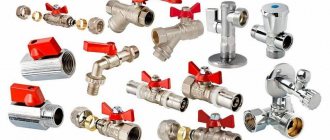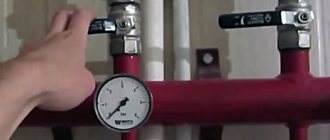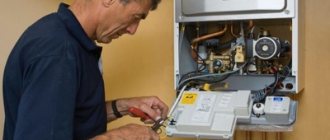How does air enter the circuit?
There are two types of contours:
Peculiar automatic air vents in an open-type heating system allow coolant to pass through them, which circulates by gravity. The direction of circulation is determined by the design of the circuit. It always maintains a slope from the highest point, on the supply flow, to the lowest, on the return. There should be no air pockets. Air enters the heating system together with the coolant, which is in contact with it in the expansion tank. Then it is drawn into the flow in the form of small particles, since it is impossible to bleed air from the heating system from a coolant with a temperature of 20 degrees. The hotter the water, the more intense the process of separation of bubbles from the coolant occurs. The liquid pushes the bubbles upward. Accordingly, they reach a peak point where they find a way out.
Since expelling air from heating is one of the key tasks for safe and efficient heating of premises, equipment specially designed for this purpose is installed in the circuit.
Closed systems are sealed and circulation in them occurs thanks to a pump. In such circuits the flow rate is higher. They are designed in such a way that air pockets are formed in them. In this case, the installation of special equipment is required, since it is necessary to bleed air from the heating system while maintaining its tightness. It's called an automatic heating system air bleeder. Since the system is not in contact with the environment and is sealed, oxygen can only enter it with the coolant.
In addition to the transit of oxygen by the coolant into the circuit, airing can occur:
- due to mechanical damage;
- due to repair work;
- in case of leakage;
- after verification work.
Since it is not possible to prevent oxygen from entering the system, it is necessary to ensure that it finds a way out. For this purpose, several types of equipment are used to perform the task. They can work autonomously or in manual mode.
Air in the water supply system
My mother-in-law has her own house in Crimea, which stands on the highest place in the village. A water consumption meter has been installed. Water is supplied by a pump every hour. After the end of the water supply, houses located in the lowlands have water for another three hours (the mother-in-law’s water stops flowing immediately after the pumps are turned off). Naturally, air gets into the water supply system. The next day, this air happily spins the water flow meter. It takes about 40 minutes until the water starts. During this time, the meter can wind several cubes, passing air through it.
How to solve the problem of bleeding air from the water supply system without paying for air-wound cubes?
Install an air vent in front of the meter. I don't know if you have the opportunity to do this yourself. but I think this issue needs to be resolved with a responsible organization. We call it a water utility.
A good tool compensates for crooked hands.
What is an air vent? Model, type, type. Where can I read about it? I can do it myself. I don’t want to touch the water supply system.
Search for air vent. you’ll find one, you probably need one that can be filled, but I don’t know if there are any. The air is released automatically before water enters; the only drawback is that if debris gets in, it may not work correctly.
A good tool compensates for crooked hands.
Amazing! Thanks for the tip. I don't need it to be filled. I will install it in front of the meter, but in a different place, so as not to contact the inspection authorities - they are evil and really want money, and not solutions to problems, alas.
Read it. But I believe that it will not work in the water supply system. It is designed for heating systems. Installed at the highest point of the system. It will not work in a running water supply system. Air will flow through this type of air vent and into the pipe. There must be another solution to the problem.
I won’t argue, this can only be verified experimentally. I installed it on the same floor with hot water, it works properly, before that the dryer was often cold. There is a float in the air vent, which is lowered down and the valve is open - the air comes out. When water enters, the float floats up and the valve closes. In theory it should work.
A good tool compensates for crooked hands.
We won’t argue, but the next option is taken from life - at first only air flows, and then the air begins to be interspersed with water. As long as only air flows, such a valve will work. But as soon as water arrives, supported by air from behind, then the system will stop poisoning the air. Those. This is a kind of half-hearted solution to the problem, alas.
Although, it is possible that everything will work.
After turning off the water, leave the tap open, the meter will rewind to the same volumes.
Makarone wrote: after turning off the water, leave the tap open, the meter will rewind to the same volumes
If there is a check valve, it may not work. Without the valve it will be the same. verified.
A good tool compensates for crooked hands.
Andrey? wrote: If there is a check valve, it may not work. Without the valve it will be the same. verified.
You can take the plate off, since such nonsense is going on.
And in general, since they are evil, it means that after turning off the pump, put a compressor on the mixer and blow in the return line until the counter rewinds to zero.
Ffin wrote: Read it. But I believe that it will not work in the water supply system. It is designed for heating systems. Installed at the highest point of the system. It will not work in a running water supply system. Air will flow through this type of air vent and into the pipe. There must be another solution to the problem.
Don't talk nonsense, why shouldn't he work? There, after turning on the pumps, the pipes are generally dry, just air under pressure. He will be pitted against each other in the best possible way. There will only be an air bubble left in the pipe from the meter to the consumer. But in any case, this will be measured in maximum liters, not cubic meters.
Types of equipment and principle of its operation
- open type expansion tank.
How to remove air from a closed heating system with a simple tank? It can perform the function of an air vent only in open circuits. Since it is not possible to ventilate a closed circuit heating system using a tank. Only sealed tanks are installed in them. The open tank is at the peak of the circuit, where oxygen bubbles tend to flow. The problem is that the water is enriched with it in the same tank, so there is a high level of air in the coolant, which is there until the liquid is heated;
Installed at the highest point or in a place where oxygen accumulates. The threaded part of the heating system air bleeder comes in two diameters: ½ or ¾ inch. In shape they can be flat or bent at a right angle, like the letter “g”. The air outlet hole is located either at the end or on the side of the housing. Works offline. Air is released from the heating system when the pressure in the system rises to a critical level. Consists of a valve and a float. The working principle is that when oxygen rises, the float moves down and opens the valve. As soon as a release occurs, the float rises, returning to its original position, and closes the valve;
- air separator for heating.
Placed on the feed. Unlike an automatic air vent, it does not remove the oxygen that itself separated from the coolant and rose up. The air separator in heating independently separates oxygen particles and gets rid of them. It is designed in such a way that the flow mixes when encountering obstacles. Barriers may include:
Air separator for heating
Since they are installed in the area behind the boiler, where the temperature is highest, their operation becomes more efficient. Oxygen is more readily separated from hot water. Automatic air discharge from the heating system is carried out continuously. Works autonomously without human intervention;
Removing air from the heating system requires human intervention. The tap is located at the end of the heating radiator. This is the white “twist” on the battery with a bolt screwed into it in the middle. There is a hole in the plastic, small as a needle, since this is more than enough to bleed air from the heating radiator. In order to do this, you need to prepare a vessel for water, a half-liter jar will do, unscrew the tap a little and after the hissing stops and a trickle of water starts flowing, close it. That's it, the plug has been removed.
The air vent in the heating system, depending on the type, can be installed not only at the top point of the circuit. They are also installed in problem areas and downstream of the boiler.
How does an automatic air vent work?
When water props up the float from below, it pushes the rubber gasket and the water pressure presses the gasket into the valve body. This way the hole is closed. When the water leaves, the float sinks and pulls the rubber gasket along with it, the hole for air inlet and outlet opens.
During operation, the automatic air bleeder spits water. Why is this happening? Because air bubbles hit the float mechanism from below quite sharply and this causes a pulsed operation of the air vent. To prevent the air vent from splashing with dirty water, a thread with a diameter of 1/4 to 1/2 is provided at its outlet (depending on the model of the air vent valve RACI, ARI, Unirain,
This video shows how the RACI vent valve works
How to remove a plug from a circuit
Before removing air from the system, it must be detected. Options:
- before you bleed the air from the heating system yourself, would it be better to call a technician and get it over with?;
- try to find it yourself by knocking on the pipes. The sound in the area where the traffic jam is located will be different;
- check the uniform heating of the radiators. The top should be warm, there may be a slight difference from the bottom. The main thing is that the temperature at the top is higher. If this is not the case, then there is a problem in the batteries.
To remove air from the radiators in a private heating system, it is enough to use a Mayevsky tap. In other cases, you must first check the condition of the equipment responsible for this process. If it is in working condition, you can increase the pressure so that the plug comes out on its own, or refuel the system. If the circuit is filled from scratch, then you need to fill in water in several stages, without rushing. In this case, all taps, except the drain, must be open. We need to provide more options for oxygen to escape. Some craftsmen remove the cork by tapping along the contour. The method works, but this does not mean that you need to take a hammer and hit the pipe harder. No, you need to know how and where to hit, otherwise there will be no use, only harm.
In addition to the familiar Mayevsky taps, modern heating systems commonly use a device such as an automatic air vent. Its task is to remove air from a certain section of the heating network without human intervention. How this important device works, the principle of its operation and its installation location - all these nuances will be discussed in this article.
Physical methods
Physical methods include the use of deaerators, which can be thermal or vacuum. Electromagnetic, high-frequency and ultrasonic methods, as well as bubble nitrogen, have also been developed for water deaeration.
The thermal method is most widespread in steam and hot water boiler houses. It is based on the processes described in Henry's Law. According to him, the solubility of ideal gases in water at constant temperature and low pressure is directly proportional to the partial pressure of these gases above water. Increasing the temperature to the saturation level at a given pressure reduces the partial pressures of gases above water to zero, and therefore the solubility of gases in water decreases to zero. Due to an imbalance in the system, gases are released from the water (physical desorption).
By selecting temperature and pressure ratios at which gases become practically insoluble, it is possible to almost completely remove them from water.
In recent years, gas removal apparatus designs have been significantly improved. There are now several successful types of deaerators available, each adapted for a special purpose. There are installations for deaerating cold water without heating, producing 15,000 m 3 per day and reducing the oxygen content to 0.22 ml/dm 3. In such a device, water is sprayed into special trays in a chamber under low pressure. Gases can be removed by steam ejectors with refrigerators or vacuum pumps.
In steam boiler houses, atmospheric mixing desorbers of low excess pressure are mainly used. In such an apparatus, streams of water move downwards towards the steam coming from the steam distribution chamber, and, in contact with it, heat up to a boiling point, as a result of which the air dissolved in it is released from the water.
The device maintains a pressure of 0.12 MPa, and the water is heated to 104°C, i.e. to boiling point at this pressure. The evaporated water and air are sent through a fitting to a heat exchanger to heat the water entering the device. The nominal capacity of such deaerators is 25–300 t/h.
In boiler rooms with hot water boilers, where there is no steam, vacuum deaerators are used, which maintain a pressure of about 0.03 MPa at a boiling point of about 69°C. This vacuum is created using a water jet ejector.
The main condition for removing gases from hot water is to maintain it in a finely atomized state (for a sufficient time) at a boiling point corresponding to the pressure at which dissolved gases are freely released into the gaseous phase. With a simple type of open feedwater heater, the deaerator, when heated to 88-93°C and freely venting gases into the atmosphere, reduces the oxygen concentration to approximately 0.3 ml/dm 3 .
Design and principle of operation of the air vent
Due to various circumstances, an air lock may appear in water heating systems, preventing the normal circulation of the coolant. As a result, part of the radiator or several batteries located on the same branch or riser cool down. So that the air that appears can leave the system on its own, an air vent operating in automatic mode is installed at certain points.
The device is a sealed metal case with a connecting pipe located at the bottom. Inside the body, in the chamber, there is a float made of polymer material, connected by a rod to a needle valve, the hole of which is made at the very top of the lid. The air vent device is shown in detail in the diagram:
The normal state of the air separator is when the body is filled with coolant, the float is raised to the maximum upper position, and the needle valve is closed. Over time, air from the network enters in small portions into the chamber of the device and displaces water.
The float gradually lowers and at a critical point begins to open the valve communicating with the atmosphere through draft. Thanks to this, all the air accumulated in the chamber under water pressure quickly leaves it through the open hole. This is the operating principle of the automatic air vent, as shown in the figure:
After all the air has gone out, water takes its place in the chamber, raising the float to its original position. The valve closes and the air vent goes into standby mode. The automatic float air vent also plays a very important role when emptying the system or its section. Since when the coolant level in the chamber decreases, the lever will open the valve, this will allow air to enter the system and thereby speed up its emptying.
Air vent automatic operating principle
The automatic air vent from the heating system is a sealed brass housing, usually cylindrical or cone-shaped. The body contains a hollow float made of polypropylene or high-quality Teflon, which is connected by means of a lever to the drain valve.
The drain valve is equipped with a plastic locking cap-plug, which prevents coolant leakage in the event of a device breakdown.
The air vent will only operate when the locking cap is open. Manufacturers supply air vents with caps that are completely screwed on, this is done to prevent contamination from getting inside the housing. To start the device, the cap should be unscrewed a few turns.
- There are 3 types of automatic air vents:
- Direct traditional (installation is carried out vertically);
- Angled (at an angle of 90°). They are used as radiator valves instead of a Mayevsky tap or in cases where the design of the heating system does not allow the use of a direct air vent;
- Special air vents for radiators.
- The operating principle of an automatic air vent can be described in several “steps”:
- The air accumulating in the device body puts pressure on the float, due to which the float gradually falls down;
- Moving down, the float pulls the lever and the drain valve opens, releasing air out;
- As air leaves the housing, the float rises again, simultaneously closing the bleed valve.
The disadvantages of automatic float air vents include their demands on the cleanliness of the coolant. Due to poor-quality coolant, the air outlet hole is partially or completely clogged, which leads to loose closure of the exhaust valve.
As a result of this, coolant begins to leak. To solve this problem, you have to disassemble the air vent and clean the locking mechanism.
Another problem with automatic air vents is leakage in the area of the threaded connection between the top cover and the body of the device. The leak occurs due to a rupture of the o-ring, which is installed between the body and the top cover.
The failed ring should be replaced with a new one, or the threads should be wound with Tangit Uni-Lock or flax.
Specifications:
| Parameter | Unit change |
| Life time | up to 30 years old |
| Max. coolant temperature | 110-120 °C |
| Max. ambient temperature | up to 60 °C |
| Pressure | 10-12 bar |
| Connection thread | ½, ¾ inch |
| Coolant requirements | water, liquid non-aggressive media |
Manual air vents for radiators
Most people prefer manual air vents. The most popular is the Mayevsky crane. It is also called a needle vent valve. It is small in size and effectively removes air and heating systems.
- The Mayevsky crane circuit consists of the following:
- The locking cylinder is screwed into the hole on which the thread is applied. The entire flow of coolant is blocked. When unscrewing the cylinder, the body is lifted and thus the hole opens.
- After opening the hole, air, if any, comes out. If it is not there, then the coolant will come out.
- Automatic air vents are mounted vertically (so that the cap is directed upward) at the highest points of the heating system (upper sections of risers, heating devices, collectors, boilers, etc.). Corner models are also installed with the cap facing up.
- It is recommended to install a ball valve or shut-off valve in front of the air vent. This will allow you to replace a failed device without draining the coolant from the system.
If air accumulates in the heating radiators, it is necessary to use a special key or a screwdriver to turn the slot on the gas vent disk one or two turns counterclockwise. After this you can hear hissing.
The coolant will begin to come out with the air in a small stream. But when the coolant begins to flow out in a continuous stream, you need to close the tap and turn the key or screwdriver in the opposite direction.
When turning on the heating system, it is necessary to carry out such a procedure, but during the year it will not be superfluous to check the presence of air a couple of times. After the heating season has ended, it is recommended to check the presence of air.
But for this you cannot drain the coolant. After turning off the radiators, you can turn the tap a little. This will create a small hole through which the coolant will not be able to flow, and the resulting air will escape.
Causes of air and air locks in the heating system
Often in closed heating systems, ordinary tap water, which contains dissolved oxygen, is used as a coolant. When such water is heated, it releases oxygen in the form of a large number of microbubbles. After some time, as the bubbles accumulate, they form an air lock.
- Causes:
- When the system was filling, the coolant was “supplied” at high speed, as a result of which the air did not have time to bleed out. The system should be filled gradually, without haste (it should take about 1 hour to fill the 1st floor of an extensive heating system).
- There is a coolant leak in the heating system or some connections are not tightened tightly, resulting in air entering the system.
- The system uses polymer pipes without an anti-diffusion coating whose walls are oxygen-permeable.
- Errors in system installation can also cause air locks. This especially concerns non-compliance with the required pipe slopes, as a result of which the air “stagnates” in a certain section of the pipeline and does not reach the air vent. In this case, it is recommended to make a cut into the problem area and install an automatic air bleeder for the heating system.
- Air entered the system after repair work.
Types of Automatic Air Valves
Based on their design, devices can be divided into 3 types:
Note. Despite external differences and different areas of application, the principle of operation of the air vent remains unchanged.
The most common are traditional devices with a direct connection pipe. The scope of their application is very wide. Automatic air separators are primarily designed to release air through the highest points of the pipeline network. To do this, they are placed at the very top of vertical risers, where, according to the laws of physics, all air accumulations that appear in the pipes tend to fall. If it were not for the automatic air vents in the heating system, it would have been very difficult to manually release air from the highest points.
Closed heating systems under pressure are equipped with boiler safety groups, which are located on the supply pipeline leaving the heat generator. Along with the safety valve and pressure gauge, this group also includes an automatic air valve. Its task is to bleed air when the boiler tank is filled with water. If the piping of the unit is done prudently, then, if necessary, it can always be cut off from the rest of the system and emptied using an air vent, and refilled after servicing.
Note. Safety groups for heating must be installed on boilers that burn solid fuel.
Air vent devices are also used in some models of circulation pumps. The goal is to ensure uninterrupted operation of the pumping unit. The fact is that the pump can only move an incompressible medium - water or other liquid. The entry of air into the area of the unit's impeller threatens to completely stop the circulation of the coolant, which is what the air vent of the circulation pump is designed to prevent. Any air or steam from the boiler that enters this area will be immediately released and the pump will continue to operate.
The use of aeration for iron removal and removal of organic matter
One of the following schemes is implemented:
- Pressure - the working medium is pumped and passes through the catalyst, which significantly accelerates the oxidation reactions. The amount and strength of air exposure is regulated by the compressor; impurities are precipitated as the flow passes through a filter with sorption granules, which are then washed into the drainage.
- Non-pressure - a constantly high pressure is no longer maintained in the container, as a result of which water passes through the system somewhat slower than in the previous case, because it requires some time to be enriched with oxygen and settle. After which it is pumped into a deferrizer, partially filled with a substance that causes the transformation of dissolved elements into solid ones.
- Reagents + pressure – using a dispenser, sodium hypochlorite is introduced into the liquid, which immediately reacts due to the pressure. Then the working medium is directed into a tank with filter granules, on which impurities are deposited. Residual suspended matter is washed out with a reverse flow, and excess NaOCl is eliminated by sorption materials.
- Reagents without pressure - the scheme is similar to the previous one, the only difference is that water with a catalyst added to it is first settled in a special tank for about 30-60 minutes - to start and carry out oxidation reactions - and only then goes further through the system.
It’s the last two methods that also help remove organic matter.
Corner and radiator air vents
In different heating systems, many situations may arise when it is necessary to remove air pockets in the most inaccessible or remote places. It is impossible to list them all, as there are too many options. Where it is not possible to install a simple valve because the threaded pipe at the end is in a horizontal position, an angled air vent will do. Its pipe, coming out from the bottom, turns at an angle of 90º and can be connected to a horizontal section.
It should be noted that an angular air vent with an external threaded connection is no different from a conventional straight valve except for a rotated pipe and can be used instead of it if necessary.
Often, to automatically bleed air from batteries, instead of the traditional Mayevsky tap, some users install an angle valve. This can be relevant in an unpleasant set of circumstances, when gases are constantly formed in the network and this happens precisely in radiators. The reason is a chemical reaction of substances sometimes present in water with the aluminum alloy of batteries at elevated temperatures. There is no point in installing a valve with an angle pipe, because there is a special automatic air vent for radiators, shown in the photo:
These devices are designed for batteries only and have a suitable threaded connection. Instead of manual taps, it is preferable to place them on heaters made of aluminum or partially bimetallic, where there is also contact between the alloy and water. In other situations, the radiator air vent is mounted at will, but there is no doubt that it will bring ease of use.
Note. It is still better to equip traditional cast-iron batteries included in the centralized heating network with a Mayevsky manual tap and drain pipe.
For ease of maintenance and cleaning, complete devices are available for sale - automatic air vents with a valve. The latter is a small threaded adapter with a spring-loaded petal valve inside. The adapter is screwed onto the thread directly in front of the air vent and serves so that when the system is in operation, it can be removed and cleaned or replaced. Air vents from DANFOSS, VALTEK and many other well-known brands are equipped with similar adapters.
How does air affect heating performance?
Air in the heating system is one of the reasons for heat transfer disturbances
reduction (sometimes partial) of circulation. When the heating system becomes airy, it causes a decrease in the efficiency of its operation and excessive fuel consumption;
Air in the heating system can lead to pipe leaks
Where does the air come from in the system?
It would seem that everything is being made airtight, and the question would be quite reasonable: where does the air in the heating system come from? It is quite difficult to answer unequivocally, there are many such reasons, of which it is worth noting:
- Failure to comply with the requirements regarding compliance with pipe slopes during the installation process;
- Incorrect filling of water, as a result of which the heating system becomes airy;
- Loose connections of various components and parts can be a source of air entry, which will air the heating system;
The absence of special automatic devices (air vents) that automatically remove air from the system, or their incorrect operation;
The reasons for airing in the heating system outlined above do not cover all possible situations when and how this can happen. But they make it possible to understand why the heating system is becoming airy, and to take timely measures to eliminate this phenomenon.
Recommended reading:
Installation locations for air vents
How to get rid of air in pipes
example of installing a bleeder
If there is already air in the water supply system of a private house, but it is not equipped with bleeders, you must:
- Turn off the pumping station.
- Open all drain taps and release water and air from the water supply system. After which the pipes are filled again.
You can remove air from the water supply system once and for all using bleed or drain devices:
- mechanical valves such as the Mayevsky valve;
- automatic air vents;
- ball valves;
- valves
The design of a mechanical valve for releasing air from a water supply system is as follows: a cylindrical box, closed with a lid on top, and a thread at the bottom for connecting to the water supply. There is a threaded plug in the middle of the lid. A plastic float in the shape of a ball is suspended inside the cylinder. If there is no air in the hot water supply system, the ball rises to the hole in the plug and closes it tightly under network pressure. As soon as air enters the device, the ball moves away and the air is released. Air can enter the system through the bleeders, which is useful when repairing or inspecting networks and speeds up the drainage of water.
Air removal devices are installed in certain places in the water supply system: at the very top ends, at bends or bends. That is, where there is an increased likelihood of air accumulation.
Homemade air accumulator
In rural water pipes, air often flows mixed with water. Using such a water supply is difficult and inconvenient, and the automation does not always cope: if there is a lot of air, the water overflows like a fountain directly from the valve. Therefore, instead of an automatic air bleeder, an air accumulator . You can make it yourself; it is a tank with an outlet pipe and a tap. The diameter of the storage tank must be 5 times larger than the diameter of the water pipe, then it can work effectively.
The air accumulator is installed at the highest point of the water supply system, where it is convenient to bleed air manually. Air storage tanks are widely used in multi-storey buildings in hot water supply systems.
How to prevent air from entering the system?
Here it is necessary to consider several situations - when filling the system with coolant and during its operation. Its design must include air vents and Mayevsky taps, allowing for de-airing of the heating system. The recommendations given apply to a closed system with forced circulation.
Installation of air vents
They are placed in critical places, such as pipeline bends or their highest points. In many cases, when the heating system is constantly airing, they help cope with this problem. There are manual and automatic.
- Manual air vents. These include, first of all, the Mayevsky crane, named after the inventor. Installed at the end of the battery, thanks to it you don’t have to think about what to do if the heating system is airy. With its help, you can independently release the accumulated air.
- Automatic air vents. They allow you to solve the problem of how to ventilate the heating system without additional participation and expense.
Filling the system with water
It is carried out from the bottom up with cold water. In this case, all taps must be open, except those that drain water. Thanks to this filling, the heating system will not be aired; as the water rises, it will squeeze the air out of it. Filling is carried out smoothly; with a sharp rise in water, the formation of closed volumes and the formation of air bubbles is possible.
Filling the heating system with water
As soon as water flows through the open tap, it is closed, and so they gradually rise higher until the entire system is filled. After this, it is quite possible to start the pump; if everything is done correctly, then circulation will occur, and there is no need to rack your brains about how to bleed the heating system.
Removing air from the system during operation
However, with all the measures taken, the formation of traffic jams is possible during operation. The reasons why the heating system will air are discussed above, and we will not return to them again. However, it is necessary to consider how to properly ventilate the heating system during its operation.
When faced with such a task, you need to act as follows:
- Determine the place where the air has collected. This can be done by noise or pipes and radiators, they are colder in such places.
We are looking for a point located higher in the direction of movement of the coolant, at which there is a Mayevsky valve through which air can be released.
This is a universal, standard algorithm of actions that allows you not to think about how to eliminate air from the heating system.
The operation of heating any home largely depends on its correct installation and provision of the necessary conditions during operation. One of them is the lack of air in the heating system. The use of the necessary equipment and proper operation will create the prerequisites for its long-term and trouble-free operation.
